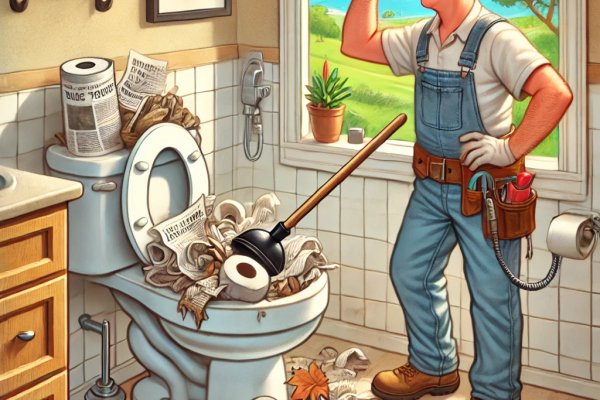
When Toilet Paper Vanishes Before Your Eyes: How Plumbers and Common Sense Save the Day
Introduction
Remember the feeling when you walk into a grocery store, expecting to grab a simple everyday item, only to find empty shelves? Over the past few years, we’ve seen our fair share of global surprises, but one of the most memorable scenes of collective absurdity was the sudden disappearance of toilet paper. This seemingly trivial phenomenon revealed our deeper household anxieties and habits. Who would have guessed that an innocent, indispensable bathroom staple could become a source of panic and long lines?
A Brief History of the Toilet Paper Shortage
If you trace how and why the “toilet paper crisis” came about, you’ll see it didn’t happen overnight. It started when news outlets hinted at possible supply chain disruptions. People discussed it on social media—someone recalled past instances when toilet paper truly disappeared from stores. Then someone went “just in case” to check the local supermarket and found only a few packs left. The domino effect kicked in: the more anxious shoppers got, the faster they cleaned out the shelves, and empty shelves fueled the panic even further.
In fact, “paper panic” has happened more than once in past decades. Sometimes it was due to production hiccups, other times due to rumors of rising wood pulp prices. In the 21st century, information moves at lightning speed, and any headline like “Toilet Paper is Running Out!” can spark mass hysteria. People rush to buy more “just in case,” which, ironically, causes the shelves to empty out even faster.
Why We Depend on Rolls So Much
Toilet paper seems so basic and ubiquitous—it’s sold almost everywhere and usually costs next to nothing. But the minute it disappears from shelves, we start to feel genuine stress. Few people can imagine how to cope without this mundane yet crucial comfort item.
In my plumbing practice, I’ve encountered clients who bought 50 or 60 rolls, even though they lived alone and barely spent any time at home. Others raced to purchase industrial-sized packs intended for large office dispensers. In most cases, there wasn’t a genuine shortage; people simply wanted to protect themselves against possible trouble.
That’s psychology at work: the moment we believe there’s a scarcity, we try to stockpile more than we need. And then the plumbing side of it kicks in: if there really is no usual paper, people start using all kinds of “substitutes.” That’s where it gets interesting...
Alternatives That Frighten Plumbers
When shelves go bare, many people turn into makeshift inventors—though sometimes less like NASA engineers and more like ill-informed tinkerers. Logically, you might think they’d choose reusable cloths or special flushable wipes. But in reality, plumbers often find all sorts of foreign objects in the pipes. Here’s a quick list of “substitutes” that are best kept far away from your toilet:
Common Culprits:
- Wet wipes: They’re hugely popular as a “comfortable” alternative, but not all wipes dissolve in water. Even if the package says “flushable,” they can still clog pipes—especially when flushed in large quantities.
- Newspapers, magazines, and office paper: Printing paper is typically too dense to break down well, causing serious blockages in the sewer lines.
- Paper towels: They’re made to absorb moisture and stay intact, making them a perfect recipe for a clogged toilet.
- Cloth scraps: Some have resorted to flushing rags. Once in the system, fibrous material tangles easily, leading to a full blockage.
- Plant leaves: Occasionally, in rural areas, people experiment with leaves. The results can be disastrous if the leaves accumulate and block the pipes.
All these “innovations” might look like a clever fix in the heat of the moment, but the outcome is almost always costly repairs.
What the Professionals Think (and Why Texas Is Not Left Behind)
One thing we know for sure: a toilet paper shortage isn’t the end of the world if you apply common sense (and keep a modest stash on hand). Plumbers around the globe recommend several solutions, such as:
Practical Tips:
- Install a bidet or handheld bidet sprays (“shower toilets”): Common in Europe and seeing growing interest in the U.S. during crises.
- Use flushable wipes correctly: Ideally, these should disintegrate in water, but even they can cause clogs if used excessively.
- Watch the volume: Even regular toilet paper can create a clog if you use too much at once.
The Texas Perspective:
In Texas, where the hot climate and occasional water supply issues can make toilet paper more scarce—and expensive—homeowners often prefer to invest in mini-water tanks or extra handheld sprayers. Texas bathrooms also tend to be more spacious, making it easier to install additional fixtures.
A Personal Story: When Panic Got the Better of Someone
The most absurd case I witnessed involved a person who decided to “play it safe” by buying such a huge amount of toilet paper that he could barely get it all home. He stuffed his entire storage closet with rolls, thinking he was bulletproof. But after a couple of months, it turned out his closet was quite humid. Most of the rolls got damp, losing their quality and turning into a soggy mess.
The unhappy ending? Wasted money, mold in the closet, a musty odor, and—when toilet paper was actually needed—none of his massive stockpile was usable. This scenario perfectly illustrates why it’s not wise to hoard toilet paper in large quantities if you can’t store it in good conditions.
A Plumber’s Advice: How to Avoid Trouble
- Keep moderate supplies: Have enough for a week or two to avoid panic hoarding.
- Consider a bidet or handheld bidet spray: Particularly useful in hot climates like Texas.
- Use fixtures properly: Only flush what truly dissolves in water.
- Preventive check-ups: Regularly inspect pipes and siphons to catch clogs early.
- Stay calm: Don’t get swept up by social media hype.
The Ecological Aspect
One reason many people seek alternatives is environmental concern. Making toilet paper requires wood and water, and during a panic, this consumption shoots up. If you must buy in bulk, look for brands that use recycled materials or have eco-friendly certifications. Some manufacturers offer truly flushable wipes or paper that disintegrates in seconds, leaving pipes clear.
When It’s Time to Call the Pros
If you notice that the toilet water drains slowly or starts to rise higher than normal—or you catch a foul odor—it’s time to act. Don’t wait for a full-blown “sewer catastrophe.” In Texas, where summer droughts and water restrictions complicate the situation, calling a plumber at the first sign of trouble is crucial.
Conclusion: Common Sense Is Your Best Defense
A “toilet paper panic” may seem ridiculous until it hits you personally. But even if store shelves suddenly become bare, there’s no need to panic. Keep a small backup supply, consider alternative hygiene methods, and stay grounded in reality. A quick consultation with a professional plumber can save you from a world of trouble later on.






